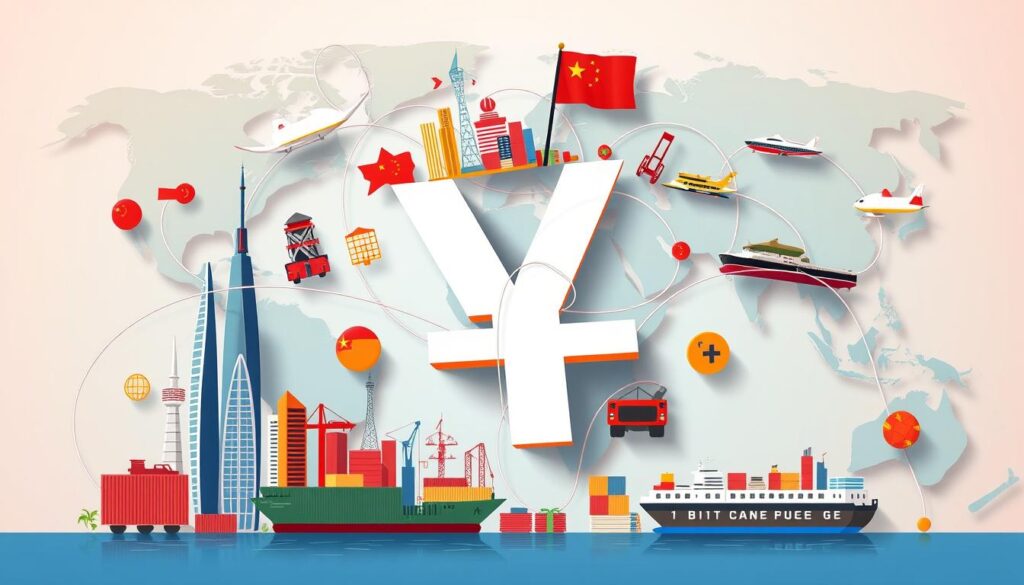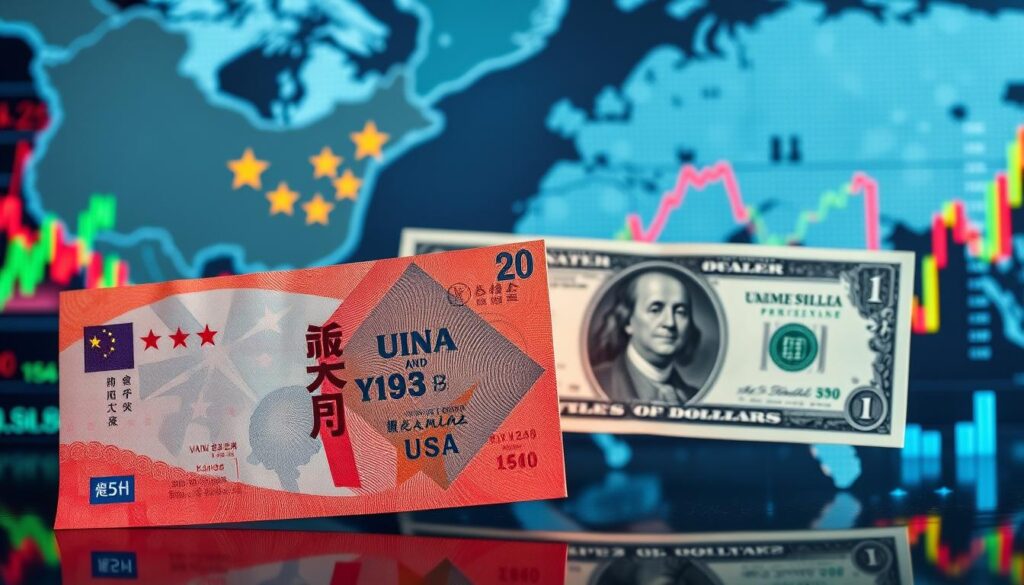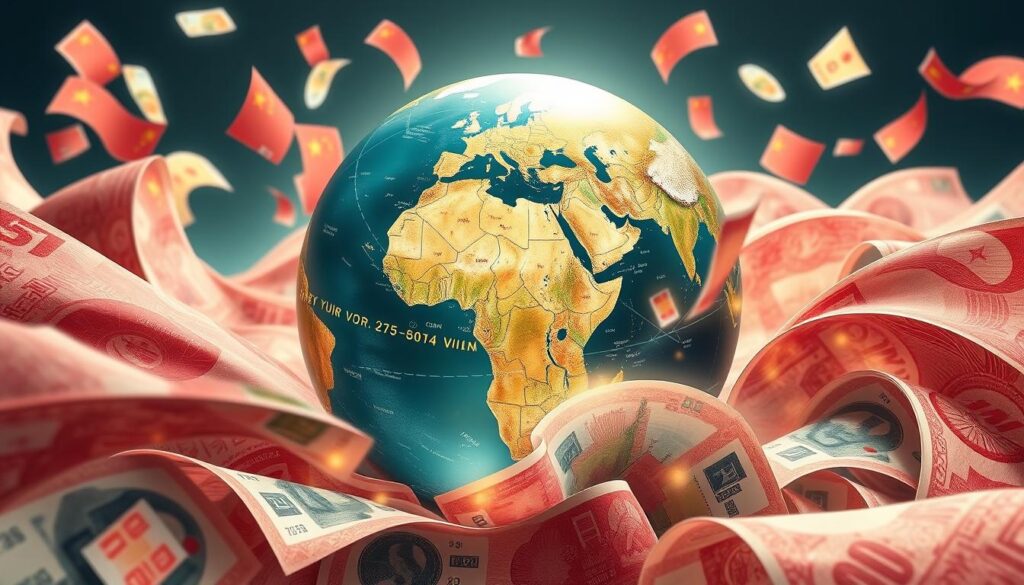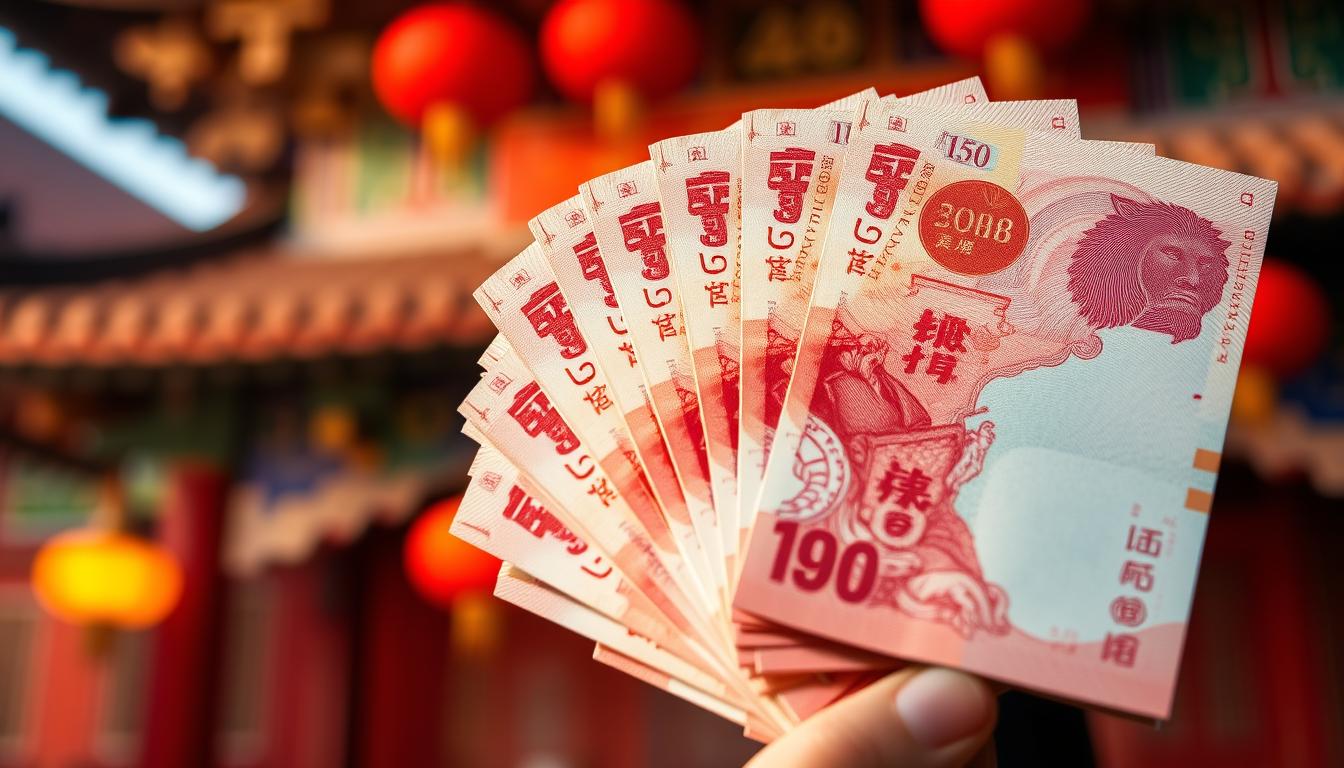China’s currency, the yuan, is a key player in the world’s finances. In this guide, I’ll cover its history, role, and impact. You’ll learn how the yuan affects global trade and markets.
The yuan’s journey is fascinating. I’ll explain its history and its current role in the global economy. We’ll look at the yuan’s exchange rate system and policies. I’ll also discuss onshore and offshore yuan trading.
Its internationalization efforts and role in digital currencies will be explored. We’ll talk about what happens if the yuan’s value drops. This article is for investors, business professionals, and anyone interested in global economics.
Key Takeaways
- The Chinese yuan, also known as the renminbi (RMB), is a crucial player in the global economy.
- This article explores the history, role, and impact of the yuan, providing a comprehensive understanding of this dynamic currency.
- I will delve into the relationship between the yuan and the renminbi, the yuan’s exchange rate system and policies, and the differences between onshore and offshore yuan trading.
- The yuan’s internationalization efforts, its role in digital currency initiatives, and the potential implications of yuan devaluation on global markets will also be discussed.
- This guide is designed to equip readers with the knowledge they need to navigate the complex world of the Chinese yuan.
Understanding the Chinese Yuan: A Comprehensive Overview
The Chinese yuan, also known as the renminbi (RMB), is China’s official currency. It has a long history, playing a key role in China’s economy and global influence. Knowing about this currency is important for international trade and finance.
Historical Background of Chinese Currency
The yuan has changed a lot over time. It started with ancient Chinese currencies like the tael and the jiao. The modern yuan was introduced in 1949, after the People’s Republic of China was established.
The Yuan’s Role in Global Economics
The yuan is now a big player in the global economy. China’s currency is crucial for international trade, investment, and financial deals. The Chinese government wants the yuan to be as important as the U.S. dollar.
Key Features of Modern Chinese Currency
The modern yuan has unique features. It has a dual-track exchange rate system and capital controls. These features make the yuan special in the global financial world.
Learning about the yuan’s history, global role, and key features helps us understand China’s economy and currency better.
The Relationship Between Yuan and Renminbi (RMB)
The yuan and renminbi are often used together when talking about the Chinese currency. But, it’s key to know the difference between them. They are the same currency, but with some important distinctions.
“Renminbi” (RMB) is the official name of China’s currency, meaning “people’s currency.” It’s the money used in China and is given out by the People’s Bank of China. The “yuan” is the basic part of the renminbi, like how the dollar is part of the US dollar.
- The yuan is the actual money, like coins and banknotes. The renminbi is the wider term for the Chinese currency.
- Outside of China, people usually talk about the yuan. It’s the standard unit for Chinese currency deals.
- In China, people often say renminbi. It’s the official name for the currency.
Knowing the difference between the Chinese yuan and renminbi is important. They are often used the same way but have different meanings and uses.
“The Chinese yuan and renminbi are like two sides of the same coin – they represent the same currency, but with nuanced differences in their usage and context.”
In short, the yuan and renminbi are the same currency. But, the renminbi is the official name, and the yuan is the basic unit. Knowing this is key when talking about the Chinese currency and its role in the world economy.
How the Chinese Yuan Functions in International Trade
The Chinese yuan, also known as the renminbi (RMB), is key in global trade. China’s currency helps in international commerce and influences global markets.
Trade Settlement Mechanisms
The yuan’s role in international trade has grown slowly but surely. China encourages using the yuan in cross-border deals. It has set up yuan clearing banks and offshore markets.
It also has currency swap deals with many countries. This makes it easier for businesses to trade.
Impact on Global Commerce
The yuan’s rise in international trade has big effects on global commerce. It offers an alternative to the US dollar, making trade safer and more flexible. This also makes the yuan more appealing for investment and trading.
Yuan’s Role in Belt and Road Initiative
The Belt and Road Initiative (BRI) has made the yuan even more important. This plan aims to link Asia, Europe, and Africa with new routes. The yuan is promoted for trade and investment in this project.
This has helped the yuan become more accepted worldwide.
| Key Aspects of Yuan’s International Trade Role | Impact |
|---|---|
| Trade Settlement Mechanisms | Increased flexibility and reduced currency exchange risks for businesses |
| Impact on Global Commerce | Reduced reliance on the US dollar, increased liquidity and accessibility of the yuan |
| Yuan’s Role in Belt and Road Initiative | Expanded exposure and acceptance of the yuan in global markets |
The yuan’s role in global trade is set to grow. This could change how we do business across borders in the future.

Yuan Exchange Rate System and Policy
The Chinese yuan, also known as the renminbi (RMB), is key in the global finance world. The yuan’s exchange rate and policies are closely watched. This is because China’s currency management affects the world economy.
China uses a managed float for its exchange rate system. This means the yuan’s value is not just set by the market. The Chinese government and the People’s Bank of China (PBOC) also play big roles. They set the yuan’s daily rate and control its changes within a certain range.
The Chinese currency policy tries to keep the yuan exchange rate stable and competitive. It balances supporting China’s economy and controlling inflation. Over time, China has let the yuan’s rate move more freely.
Knowing how the yuan’s exchange rate works is important for businesses and investors. As China’s role in global trade and investment grows, the yuan’s performance will keep economists and policymakers busy.
“The stability of the yuan exchange rate is not only a domestic issue but also has significant implications for the global economy.”
Differences Between Onshore and Offshore Yuan
The Chinese yuan has an interesting split between onshore and offshore markets. Knowing these differences is key for those into yuan trading and global economics.
Trading Restrictions and Regulations
The onshore yuan, or CNY, faces strict rules from the Chinese government. Only domestic banks and people can trade it. On the other hand, the offshore yuan, or CNH, trades freely in international markets. It has fewer rules, offering more freedom.
Price Disparities and Market Impact
Because of these rules, the onshore and offshore yuan prices differ. This price gap, or “basis,” changes based on demand, money flows, and market mood. These differences affect global trade, investment, and how people see the yuan’s value.
The offshore yuan market is key in making the yuan accepted worldwide. As more deals happen in CNH, it can change the yuan’s rate, liquidity, and role in global trade and investment.

“The distinction between onshore and offshore yuan is a complex but important aspect of understanding China’s currency and its place in the global economy.”
Understanding the onshore and offshore yuan markets helps businesses, investors, and policymakers. They can make better choices when dealing with the Chinese currency.
Yuan to USD: Understanding the Exchange Dynamic
The exchange rate between the Chinese yuan (CNY) and the US dollar (USD) is key in global trade and finance. China, the world’s second-largest economy, has a big role in international markets. Knowing how the yuan-to-USD exchange works is vital for businesses, investors, and policymakers.
The yuan’s value is shaped by many things like economic growth, inflation, interest rates, and government actions. China’s central bank, the People’s Bank of China (PBOC), works to keep the yuan stable. This helps meet the country’s economic goals. The yuan can move within a set range against the US dollar.
| Year | Yuan to USD Exchange Rate |
|---|---|
| 2020 | 6.5 |
| 2021 | 6.4 |
| 2022 | 6.7 |
The yuan-to-USD exchange rate greatly affects international trade and investment. A stronger yuan makes Chinese exports pricier for others. But a weaker yuan can make Chinese goods more competitive worldwide. It also changes how much Chinese people can buy and the value of foreign investments in China.
It’s important for businesses and investors to understand the yuan-to-USD exchange rate. By knowing what influences it, they can make smarter choices. This helps them manage risks and find new opportunities in the global economy.

The Yuan’s Journey Toward Internationalization
The Chinese yuan, also known as the renminbi (RMB), is becoming more important worldwide. It has reached key milestones, like being included in the International Monetary Fund’s (IMF) Special Drawing Rights (SDR) basket.
Inclusion in IMF’s Special Drawing Rights
In 2016, the IMF welcomed the yuan into its SDR currency basket. This move showed the yuan’s growing role in global finance. The SDR is a special foreign exchange asset made by the IMF.
Strategic Economic Partnerships
China has made strong economic partnerships with other countries. It has set up currency swap deals and yuan trading centers abroad. It also added the yuan to global payment systems like SWIFT.
The Belt and Road Initiative is a big project that uses the yuan for international deals. As China connects more with the world, the yuan’s use will likely increase.

“The inclusion of the yuan in the IMF’s SDR basket is a significant milestone in the currency’s journey toward internationalization, underscoring China’s growing economic influence on the global stage.”
The yuan is being used more in international trade and finance. China’s partnerships and the yuan’s role in global finance will keep growing. This will make the yuan even more important worldwide.
Digital Yuan: China’s Cryptocurrency Initiative
China is making waves in global finance with its digital currency, the digital yuan, also known as the Chinese cryptocurrency. This project could change how we handle money and transactions.
The People’s Bank of China is leading this effort. They aim to make the digital yuan a real alternative to traditional money, both in China and worldwide.
The digital yuan could make financial processes smoother and cheaper. It could also help more people access financial services. Globally, it might even challenge the U.S. dollar’s role in trade and investments.
But, there are hurdles to overcome. People worry about privacy, security, and government watching. As China works on the digital yuan, the world waits to see its impact on finance.
“The digital yuan could be a game-changer in the world of digital payments and international finance.”

Key Aspects of the Digital Yuan
- Developed by the People’s Bank of China, the country’s central banking authority
- Aims to provide a secure, efficient, and government-backed digital currency alternative
- Designed to enhance financial inclusion and reduce transaction costs domestically
- Potential to challenge the dominance of the U.S. dollar in international trade and investment
- Concerns about data privacy, cybersecurity, and increased government surveillance
The digital yuan is an exciting development in finance. Its growth and impact on global finance are worth watching.
Impact of Yuan Devaluation on Global Markets
The devaluation of the Chinese yuan has had a big impact on global markets. China’s currency policies are watched closely by investors and policymakers around the world. This is because China is the world’s second-largest economy.
Economic Implications
The yuan devaluation has made Chinese exports cheaper for buyers abroad. This has raised worries about unfair trade and a currency war. Other countries might devalue their currencies to stay competitive.
This has caused big changes in global supply chains and financial markets. There’s more volatility and uncertainty now.
Trading Partner Responses
- The United States has expressed concerns about the yuan devaluation. Some policymakers want a more transparent exchange rate system in China.
- European Union leaders have also spoken out. They warn that the yuan devaluation could start a global currency race to the bottom.
- Japan, a major trading partner of China, is watching closely. It’s thinking about how to protect its economy from the yuan’s impact.
| Country | Response to Yuan Devaluation |
|---|---|
| United States | Expressed concerns, called for more transparency |
| European Union | Warned of potential for damaging global currency war |
| Japan | Closely monitoring the situation, considering policy responses |
The yuan devaluation shows how connected the world economy is. It highlights the need for international coordination and cooperation to handle currency challenges.
Yuan Investment Opportunities and Risks
The Chinese yuan is becoming more important in global markets. Investors are looking to make money from its growth. But, they need to know the risks and challenges first. We’ll look at the good and bad sides of investing in the yuan.
Exploring Yuan Investment Opportunities
The yuan, or renminbi (RMB), is seen as a good investment for China’s growth. Yuan investment can be done in many ways, like:
- Buying yuan-denominated assets, such as Chinese government bonds or corporate securities
- Participating in the offshore yuan (CNH) market, which allows for greater flexibility in trading the currency
- Investing in yuan-based exchange-traded funds (ETFs) or mutual funds
- Engaging in yuan-based forex trading, leveraging the currency’s fluctuations
These options let investors benefit from the yuan’s expected rise and China’s economic growth.
Navigating Chinese Currency Risks
Investing in the yuan has its risks that investors should think about:
- Currency fluctuations: The yuan’s exchange rate is controlled by China, causing volatility that can affect investment value.
- Capital controls: China’s strict capital controls can limit moving funds in and out, affecting investment liquidity.
- Regulatory changes: China’s financial market rules often change, creating uncertainty for investors.
- Geopolitical tensions: Trade disputes or diplomatic issues between China and other countries can impact the yuan and investments.
Smart investors need to understand these Chinese currency risks and plan how to manage them. This way, they can navigate the yuan investment world better.
Investing in the yuan should be a well-thought-out decision. It’s important to know the market, rules, and your own risk level. By carefully looking at the pros and cons, investors can make smart choices and benefit from China’s currency growth.
Future Prospects of the Chinese Yuan
The global economy is changing, and so is the Chinese yuan’s future. Its path to becoming a global reserve currency is slow but promising. Many are watching its progress closely.
Potential as Global Reserve Currency
The yuan’s rise as a global reserve currency depends on several things. China’s economic growth and the yuan’s use in international trade are key. Also, China’s commitment to financial reforms matters a lot.
Experts say China’s growing influence will make the yuan more important in the world. This could happen as China’s role in global finance grows.
Technology Integration Challenges
One big challenge for the yuan is using new financial technologies. The world is moving to digital money, and the yuan needs to keep up. China is working on a digital yuan, a cryptocurrency.
But, using blockchain, digital wallets, and handling cross-border payments is hard. The yuan must stay competitive and appealing to more people worldwide.
The yuan’s future is full of both chances and hurdles. It has a strong chance to become a global reserve currency. But, it must successfully use new financial technologies to succeed globally.
| Factors Influencing Yuan’s Future | Potential Opportunities | Potential Challenges |
|---|---|---|
| Economic growth | Increased global usage and influence | Geopolitical tensions and trade disputes |
| Financial reforms | Inclusion in global reserve currencies | Regulatory and policy uncertainties |
| Digital currency integration | Increased cross-border transactions | Technological integration and adoption |
How to Trade and Invest in Yuan
The Chinese yuan (yuan) is becoming more important in global markets. Investors are looking to add it to their portfolios. Whether you want to trade yuan directly or invest in yuan assets, knowing the market is key. Let’s explore how to trade and invest in yuan.
Accessing the Yuan Market
There are many ways to invest in yuan. Some popular choices include:
- Yuan Spot Trading – Directly exchanging one currency for yuan in the foreign exchange (forex) market.
- Yuan Futures and Options – Derivative instruments that allow you to speculate on the yuan’s future price movements.
- Yuan-Denominated Bonds – Fixed-income securities issued by Chinese companies or the government, offering yuan-based returns.
- Yuan-Focused Mutual Funds and ETFs – Investment vehicles that provide diversified exposure to yuan-based assets.
Investment Strategies
There are different strategies for trading or investing in yuan. These include:
- Yuan Carry Trade – Borrowing in a low-yielding currency (e.g., USD) to invest in higher-yielding yuan-denominated assets.
- Yuan Hedging – Using yuan-based instruments to mitigate currency risk in international transactions or investments.
- Yuan Speculation – Trading yuan-based assets to capitalize on expected price movements, either appreciations or depreciations.
Risk Management Considerations
Trading or investing in yuan comes with risks. Key considerations include:
- Currency Volatility – The yuan’s exchange rate can fluctuate significantly, impacting the value of your investments.
- Regulatory Changes – China’s monetary policy and capital controls can evolve, affecting yuan-based markets.
- Liquidity Challenges – The yuan’s offshore market may experience limited liquidity, particularly during periods of market stress.
Understanding these factors and using risk management strategies can help investors in the yuan market. This way, they can take advantage of the opportunities it offers.
| Investment Vehicle | Advantages | Disadvantages |
|---|---|---|
| Yuan Spot Trading | Direct exposure to yuan price movements, potential for short-term gains | High volatility, complex trading dynamics, regulatory restrictions |
| Yuan Futures and Options | Leverage, ability to hedge currency risk, diverse trading strategies | Derivative complexity, liquidity concerns, counterparty risk |
| Yuan-Denominated Bonds | Stable income, diversification, potential for capital appreciation | Interest rate risk, credit risk, limited market depth |
| Yuan-Focused Funds and ETFs | Diversification, professional management, accessibility for retail investors | Fees, tracking errors, potential lack of pure yuan exposure |
“The yuan’s global prominence will only continue to grow, making it an increasingly essential component of savvy investors’ portfolios.”
As the yuan’s importance grows, understanding yuan trading and investment strategies is key. By managing risks and opportunities, you can unlock the yuan’s potential and diversify your investments.
Common Misconceptions About the Yuan
The Chinese yuan, also known as the renminbi (RMB), is widely talked about. But, many myths surround this currency. As a professional journalist, I aim to clear up these misconceptions about the yuan.
Myth 1: The Yuan is Undervalued
Many believe the yuan is undervalued by China to get an unfair trade edge. But, the yuan’s value is now more market-driven. The government has allowed more flexibility in its value.
Myth 2: The Yuan is Not Freely Convertible
Some think the yuan can’t be easily exchanged like the U.S. dollar or Euro. Yet, China is making the yuan more open to international investors. It’s becoming more accessible.
Myth 3: The Yuan is Only Used in China
Many believe the yuan is only for China. But, it’s gaining use in global trade and finance. It’s becoming a key player in international transactions and as a reserve currency.
| Myth | Fact |
|---|---|
| The Yuan is Undervalued | The yuan has been moving towards a more market-driven exchange rate in recent years. |
| The Yuan is Not Freely Convertible | China has been steadily liberalizing its capital account and making the yuan more accessible to international investors. |
| The Yuan is Only Used in China | The yuan is increasingly being used in international trade and finance, with a growing role in global transactions and as a reserve currency. |
By clearing up these myths, we get a clearer view of the yuan’s role in global finance.
“The yuan is a crucial component of the global financial landscape, and it’s important to separate fact from fiction when discussing its significance.”
Conclusion
The Chinese yuan is becoming more important in global markets. Its journey toward becoming a key currency shows China’s big plans. The yuan’s role in the Belt and Road Initiative and the digital yuan highlight China’s goals.
The yuan affects trade and global commerce in big ways. It has different forms, like onshore and offshore yuan. Its exchange rate with the US dollar shows the yuan’s complex role worldwide.
The yuan’s future is full of possibilities and challenges. It could become a global reserve currency, thanks to new technologies. Understanding the yuan impact and the Chinese currency future is key for businesses and investors.
FAQ
What is the Chinese yuan?
The Chinese yuan, also known as renminbi (RMB), is China’s official currency. It’s widely traded and important in global finance.
What is the relationship between the yuan and renminbi?
Yuan and renminbi are the same currency. Renminbi is the official name, and yuan is the basic unit. They both refer to China’s currency.
How does the Chinese yuan function in international trade?
The yuan is key in international trade. It’s used for settling trades, pricing goods, and investments. China aims to increase its use globally.
What is the yuan exchange rate system and policy?
China uses a managed floating exchange rate system for the yuan. The central bank sets a daily rate and allows some fluctuation. The goal is to keep the yuan stable.
What are the differences between onshore and offshore yuan?
Onshore yuan (CNY) is traded in mainland China. Offshore yuan (CNH) is traded outside, mainly in Hong Kong. They have different rates and rules due to market access and regulations.
How does the yuan’s exchange rate against the US dollar affect global markets?
The yuan’s rate against the US dollar is watched closely. It affects global trade, investment, and the economy. Changes can impact Chinese exports and the economy’s strength.
What is the digital yuan, and how does it differ from traditional Chinese currency?
The digital yuan, or e-CNY, is China’s central bank digital currency. It’s a digital version of the yuan, aiming to modernize China’s finance and promote the yuan’s use globally.
How has yuan devaluation impacted global markets?
Yuan devaluation can cause stock market swings, trade balance changes, and investment shifts. The Chinese government’s yuan management is watched by investors and policymakers worldwide.
What are some investment opportunities and risks associated with the yuan?
Investing in the yuan offers diversification and Chinese market exposure. But, it comes with risks like currency changes, capital controls, and regulatory shifts. Investors should weigh the potential gains and losses before investing in yuan-denominated assets.
What are the future prospects of the Chinese yuan?
The yuan’s future depends on China’s economic growth, financial reforms, and currency internationalization efforts. Its potential as a global reserve currency and integration with new financial technologies will influence its future.



